This story was reported before the February 2021 military coup in Myanmar. Details within may be outdated.
When in doubt, follow the elephants.
Preserved in the months-old monsoon mud, their footprints form a staircase for us to climb up the mountain’s steep spine. Dried leaves crunch loudly underfoot with each step. Gibbons howl from the neighboring ridge. Hornbills flap along lazily above the valley. And beyond the elephant trail, I gaze down over one of the world’s last teak forests.
I’m walking through the heart of Myanmar, where decades of uncontrolled logging came close to destroying these ancient forests. But with recent political change comes great opportunity. The scientists I’m following are here collecting data to support the Myanmar government’s forestry reform, which will help protect both the biodiversity within these forests and the ecosystem services they provide to Myanmar’s people.
Burma’s Arboreal Icon
Despite centuries of selective logging, Myanmar has the highest proportion of forest cover in mainland Southeast Asia and some of the region’s most intact forests. They also contain exceptional biodiversity, including fishing cats, sun bears, dholes, binturongs, pangolins, and more than 1,000 bird species. Myanmar’s forests are also home to 70 types of commercially valuable tree, including varieties of ironwood (Xylia xylocarpa) and rosewood (Pterocarpus indicus). But the species that makes Myanmar famous — shaping the country’s history and driving its economy — is teak.
“Teak is our national icon, our heritage,” says Tint Lwin Thaung, a Burmese conservationist who has worked in Myanmar for several decades. Tectona grandis borders on the miraculous. Naturally rich in oils, it’s a durable, easily shaped wood that deters pests and is extremely water resistant, even when left untreated. Used in boatbuilding for more than 2,000 years, teak is still popular today for boat construction and decking.
Teak is our national icon, our heritage.
Tint Lwin Thaung
After an hour of steady climbing we turn right into the trees, following a barely perceptible footpath down into the valley. Soon we’re surrounded by giants. Dozens of massive teak, ironwood, and rosewood trees form a grove around us, their wide boughs supporting aerial gardens of orchids and staghorn ferns. The night before, the forest rangers warned us about sunbears, snakes, and wild boar, but the din of our feet crunching fallen leaves has since scattered any wildlife, save the distant gibbons.
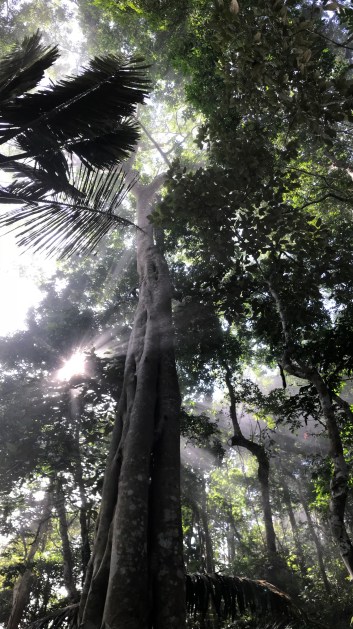
By the mid-1800s, the British ruled an empire spanning much of the globe. Their dominance depended heavily on naval power, which in turn depended on supplies of shipbuilding material. Already well established in neighboring India, the British quickly realized the value of Myanmar’s teak forests and fought three wars, from 1824 to 1885, to annex the country as a territory of India and secure access to teak, oil, and rubies.
We pass one ancient tree with a diameter greater than 5 feet, or 1.5 meters. At least 150 years old, this giant began its life when the country was still ruled by kings, yet remained young enough to escape the attention of colonial foresters.
During their rule, the British implemented a forest management system that is still influential to this day. A handful of private companies, including the famed Bombay Burmah Trading Corporation, leased rights to log sections of forest on a 30-year cutting cycle.
After locating a tree of harvestable size, the loggers cut away a thin strip of bark around the entire trunk. Left standing, these girdled trees died and dried out slowly. A few years later the loggers would return — with axes and elephants — to fell the tree.
Then they would bore holes through one end of the trunk and hitch it to one or two working elephants. With the aid of their mahout masters, the elephants dragged the 1- to 2-ton logs through the dense forest to the nearest streambed, one at a time. Then they waited. Within months the monsoon would come, turning the trickling forest streams into roiling whitewater torrents that blasted hundreds of massive logs, each at least 30 feet long and 7 feet wide, downstream to the lowland rivers.
Our guides sing as we follow the elephant trail down to one of those very streams: a narrow channel walled with water-smoothed boulders. The inch-deep trickle at the bottom is icy cold, and along the streambed I see chunks of petrified wood, some as big as bathtubs, shining reddish-yellow in the sunlight. We’ve seen these fossils everywhere — eroding out of the mountain slopes or trampled on in the bottom of dry elephant wallows — a reminder that the trees we walk beneath grow on the bones of a forest millions of years older.
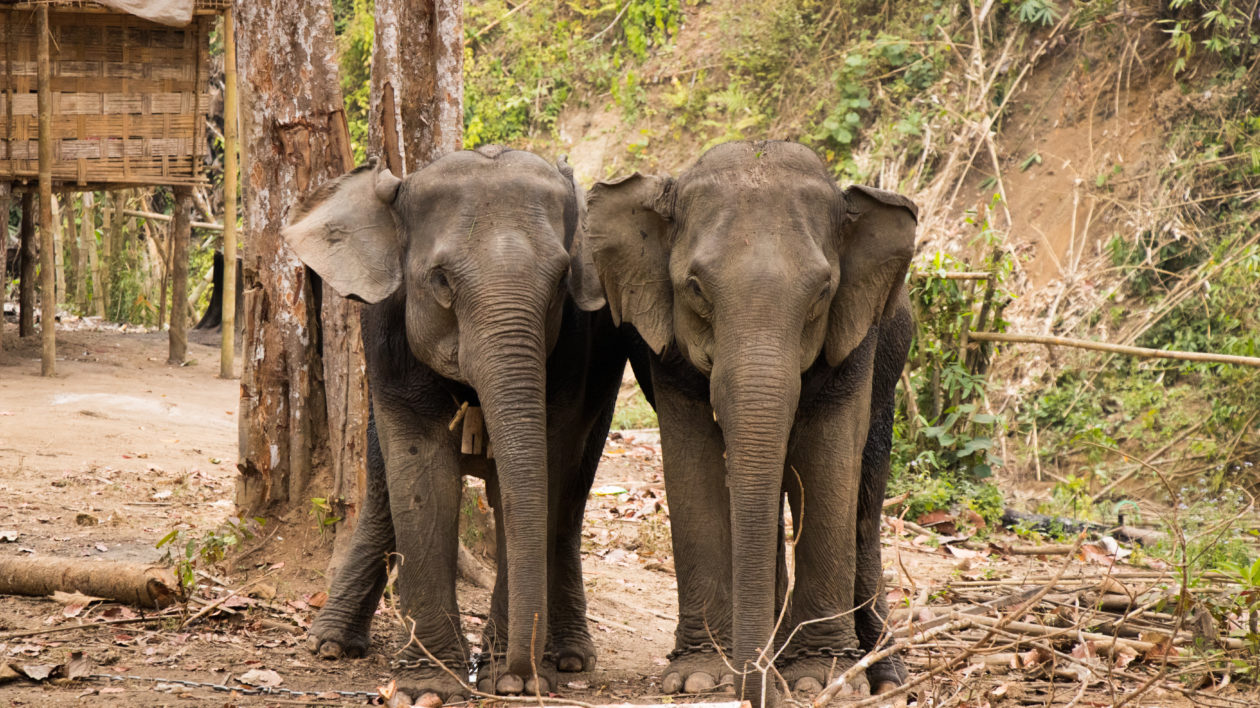
Forests at the Mercy of Politics
Reality soon intrudes, as we hear the distant rumble of a truck laden with freshly felled logs. Though British forest management was well-organized, it was still designed to extract as much wealth from the forests as possible. “During colonial exploitation it was easy for British businesses to take what they wanted,” says Oliver Springate-Baginski, researcher at the University of East Anglia who studies Myanmar’s harvest levels. “The data show it wasn’t sustainable.”
The British timber industry only lasted about 70 years, from about the 1860s to the 1930s, when civil unrest and then WW2 halted the logging industry. Despite the high extraction rates, there was only so much damage they could do in such a short period, with less advanced technology and such rugged terrain.
In 1948, Myanmar gained independence and established a parliamentary democracy. Foresters continued using the British management system and rates of teak extraction were they lowest they have ever been since 1900. “At that time, population pressure wasn’t high yet, forest resources were still good, and we had a very scientific management system, even at the regional level,” says Tint Lwin Thaung.
Then in the early 1960s, the military seized power in a coup d’état and implemented a nominally socialist government. In the decades that followed, a growing population and isolationist policies put pressure on the country’s resources. As timber extraction climbed steadily, Myanmar declined from one of the region’s richest countries to its poorest.
After years of civil unrest and anti-government protests, a second, violent military coup occurred in 1988. Condemning the government’s human rights violations, Western nations rapidly withdrew aid money and imposed economic sanctions, increasing Myanmar’s isolation. Desperate for cash to pay off international loans, the military started logging at a breakneck pace, precipitating a complete breakdown of the forestry system.
The Forest Department, which is responsible for conservation and management, would inventory timber reserves each decade and set an annual allowable cut, which dictates both the number of trees that can be extracted and where they should be logged from, distributing the impact across the country’s forests. Then the state organization responsible for harvesting timber, Myanma Timber Enterprise (MTE), would log accordingly.
But under military rule, Tint Lwin Thaung explains, the government determined the harvest levels by first setting a revenue target and then working backwards to calculate how many trees it would take to yield that cash. Instead of distributing logging around the country, they concentrated their efforts in the most accessible forests and ignored the 30-year harvest cycles.
Those logs were then sold across the border to India, China, Thailand, Singapore, and Malaysia, which have lax sustainability regulations for imported timber and are still the main importers of Burmese timber today.
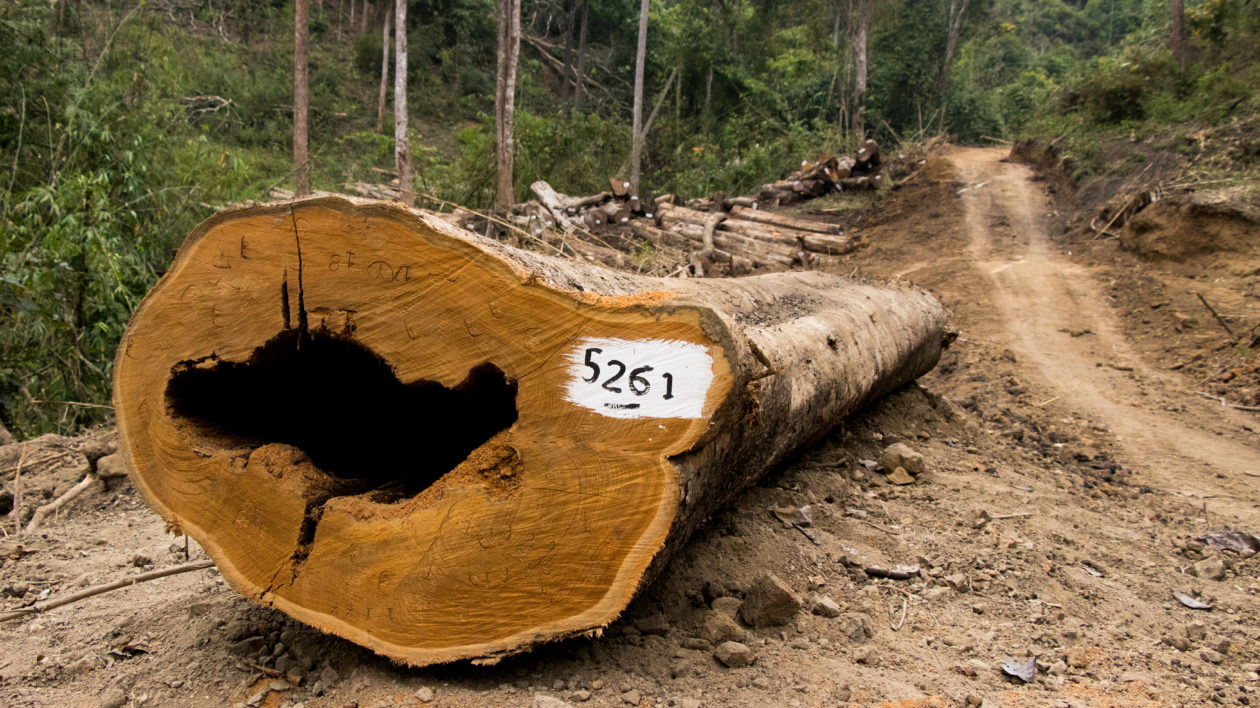
From Ruin to Relief
Devastation came quickly: between 2010 and 2015, Myanmar clocked the third highest rate of forest loss in the entire world, behind Indonesia and Brazil. “It was the worst hit for forest resources in the country,” says Tint Lwin Thaung.
Starting in 2008, the military government began relinquishing control and drafted a new constitution, which was approved via a national vote. In 2014 they banned the export of unprocessed logs, with the hope of stimulating a domestic wood-processing industry.
These early signs of political change only made the situation worse, spurring a “teak rush” where overharvesting of both teak and other hardwoods reached its peak. Before the export ban came into place, the number of trees marked for cutting in the region we were hiking through exceeded the harvesting limit for the entire country.
By 2015 the situation was at a crisis point — Myanmar lost a staggering 15 million hectares of forest since 1990. Illegal logging was rampant, trust between civilians and the government was broken, some forests were wrecked beyond repair, and what remained was in danger of disappearing forever. But the next swing of the political pendulum would bring relief, instead of ruin.
That same year, Myanmar’s people elected a democratic government in the first openly contested election in 15 years, beginning a slow process of democratization that is still in progress today. Lifting sanctions offered some economic relief, and the new government realized that they needed to act quickly to protect the country’s valuable natural resources.
In response to international pressure, the government banned logging across the country for the 2016-2017 season, buying them time to reassess their forests. Damage to the teak heartland in the Bago Yoma mountains was so severe that they extended the ban to a full decade in that region.
With a bit of breathing room, the new government launched a decade-long reform of the Forest Department, dubbed the Myanmar Reforestation and Rehabilitation Program. This reform will contribute to the country’s Paris Agreement goal of having 30 percent of the country’s forests, or 12 million hectares, under effective management by 2030, including protection and restoration. Those efforts will safeguard natural resources critical for the country’s development, and at the same time contribute to their commitments to both the Paris Agreement and Convention on Biological Diversity. But although the scale of the proposed forestry reform is both ambitious and necessary, significant challenges stand in the way.
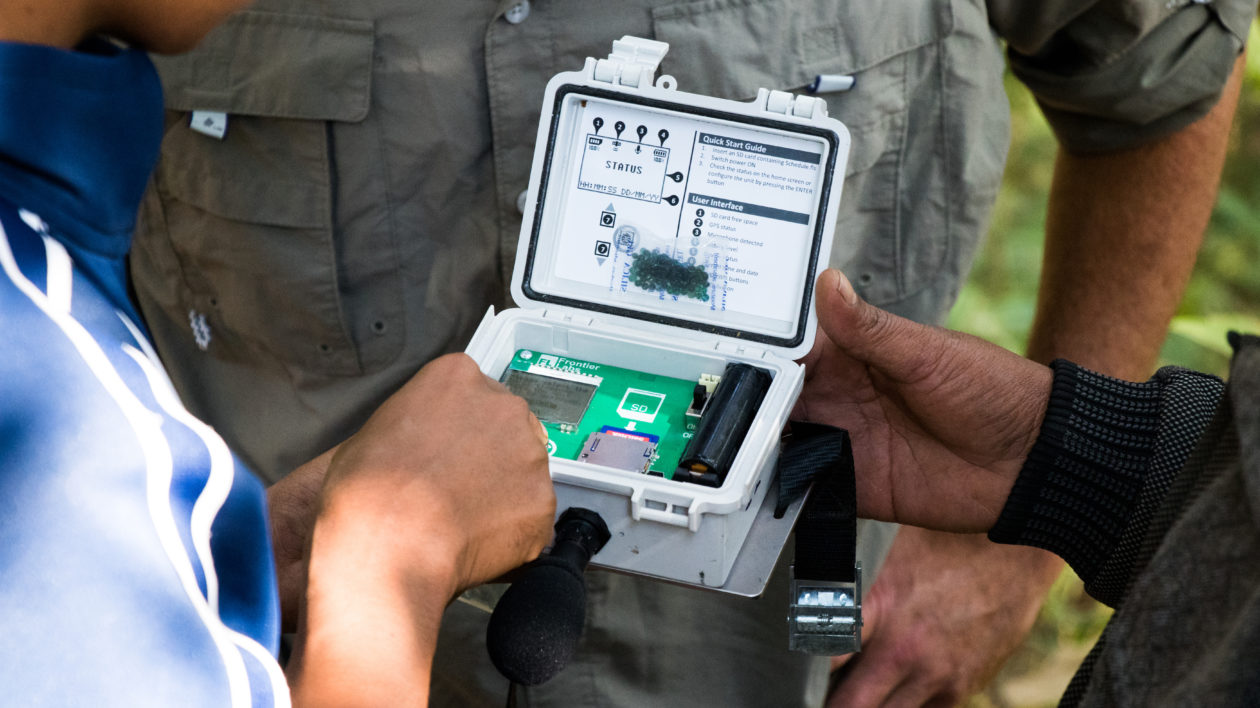
Transforming Sound into Forest Data
A few hundred meters past the stream we toss our packs down and get to work. Research assistants Ye Htut Aung and Minn Zaw Htun unpack an acoustic recorder, connect the GPS to the nearest satellite signal and screw in the microphone. I hear the thunk-thunk of a machete biting into wood, and when I turn around an MTE worker is already 10 feet up a teak tree, his feet wedged skillfully into two shallow notches in the trunk. We hoist the recorder up to him and he fastens it around the tree, well out of reach of any curious elephants that might wander past.
“The sound data we record here will be key to protecting these forests,” says Timothy Boucher, a conservation geographer, as he takes a photo of the overhead canopy and logs our location on a GPS.
Boucher explains that the reform effort outlines six different types of forestry management, ranging from pristine forest, to selectively logged forest enriched by planting teak seedlings, to commercial teak plantations. But no one knows how each of those options might alter biodiversity and ecosystem services, which the government is legally required to protect. This is precisely the data gap that conservationists hope to fill, using an unusual source of data: sound.
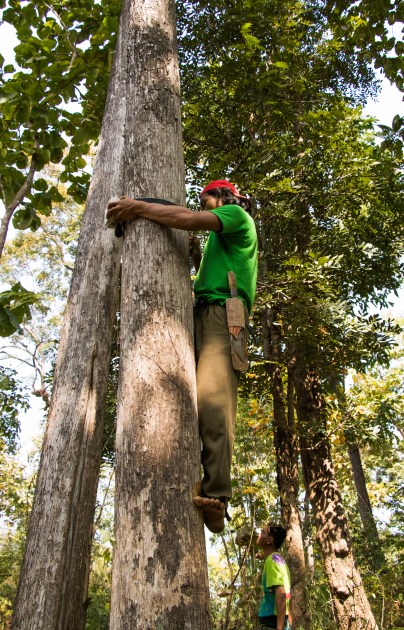
Tropical forests are noisy places; at any one point during our trek we could hear gibbons, dozens of species of birds, and the high-pitched wail of insects. These animals have evolved to vocalize at slightly different frequencies, so they can more easily communicate with members of their own species. In a healthy forest each frequency should be filled, indicating ample biodiversity. If species disappear, they will leave behind gaps in the frequency spectrum. So by recording the sounds of an ecosystem, scientists can roughly estimate its biodiversity, and therefore health.
Boucher spent four months in Myanmar recording soundscapes from each of the six forest management options in four different areas of the country. By comparing those soundscapes to ones from pristine forests, he hopes to understand just how biodiversity changes across each management type. A separate study will also allow Boucher to understand the impacts on freshwater health.
With one more recorder to go, we trek on for a few kilometers before realizing that we’ve gone too far. The elephants may know where they’re going, but judging our location in the forest is a continual guessing game — even with a GPS — because the government data we’re using is off by at least 500 meters. These wonky maps are just one example of a significant challenge that stands in the way of both the reform and Boucher’s research: an extreme lack of accurate data.
“Now that we are back to a more responsible and environmentally conscious democratic government, we need to know what remains in our forests,” says Tint Lwin Thaung. “What’s left? What’s gone? Where are they? And what can we do with what’s left?”
If data to answer those questions exist, its locked in the heads of the local MTE officials who spend far more time on the ground than their Forest Department counterparts. In other cases, the information is missing entirely. After deploying recorders in the logging forests, we traveled into Pinlebu township to gather data from plantations. We walked across a fallow rice paddy, weaving between grazing water buffalo to an ironwood plantation marked on the maps. Yet all we could see was a grove of sun-weathered stumps, clearly logged long ago and then forgotten.
“It’s a fundamental problem,” says Springate-Baginski. “They just don’t know how many trees they have, which is like asking your bank manager how much money is in your account and they don’t know.”
Accurate and regularly updated knowledge of both forest and plantation resources — including functional maps — is critical to setting a truly sustainable AAC that’s based on what actually exists in the forest, and not someone’s best guess.
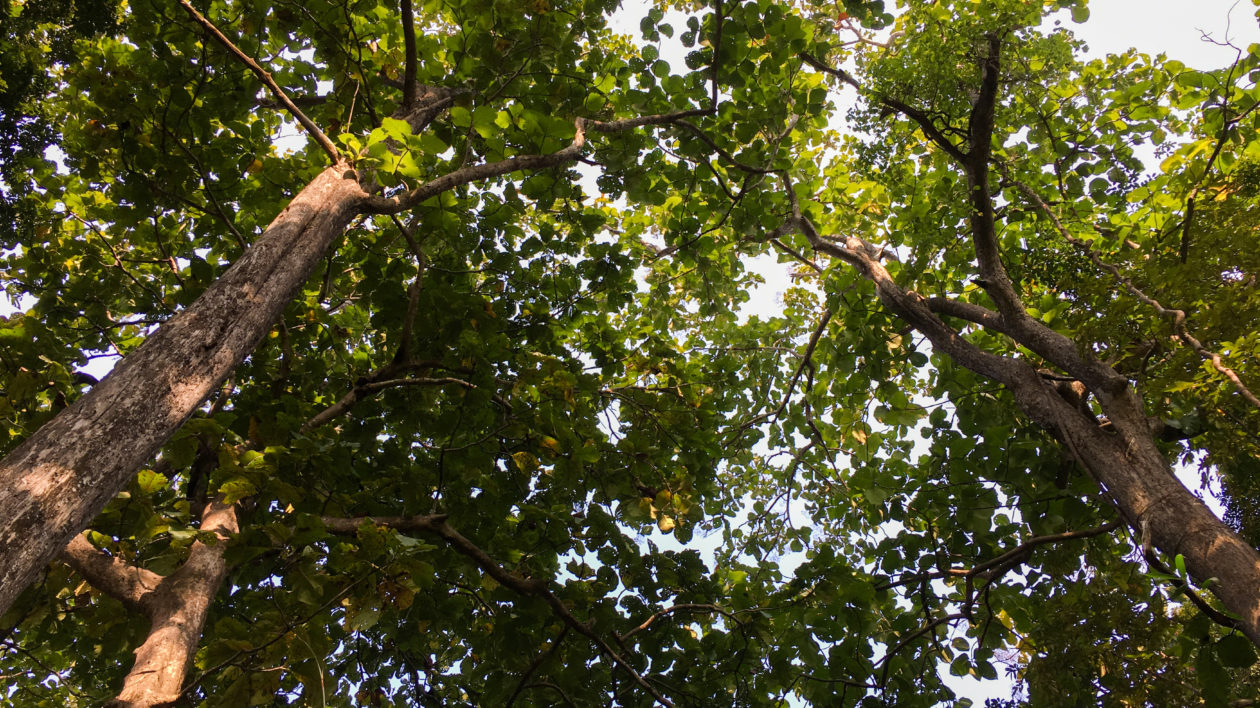
“The government needs to achieve their conservation targets and also develop the country,” says Tint Lwin Thaung, “so we need broad-thinking approaches to both development and conservation challenges.”
Conservationists hope to support both the forestry reform and reform within MTE. The first step will be to fill in some of the data gaps for forests in the Upper Ayeyarwady River basin, which stretches from the northern mountains down to Mandalay. Boucher’s acoustic data will help the government understand how different management tactics affect forest biodiversity. He will then use that knowledge to map recommendations for how the government can allocate these management options across the Sagaing province to maintain logging yields and simultaneously protect biodiversity and other ecosystem services.
“We want a win-win situation, where timber production is not reduced, but biodiversity is also protected and enhanced,” says Boucher. “But to achieve both goals we really need to plan how things are placed across the landscape.”
Those recommendations will also consider additional forest benefits, including carbon sequestration and watershed protection. Other reform efforts will focus on implementing and maintaining more sustainable logging practices, including the use of working elephants to transport logs within the forest, which minimizes road building and helps preserve forest carbon stores.
Boucher says that the decision to focus on the production forests is both practical and strategic. So much of the country is earmarked for logging that there’s no margin for error — if the logging isn’t managed sustainably, no amount of designated protected areas can save the forests. “If we continue with business as usual,” he says, “these forests have 10 years.”
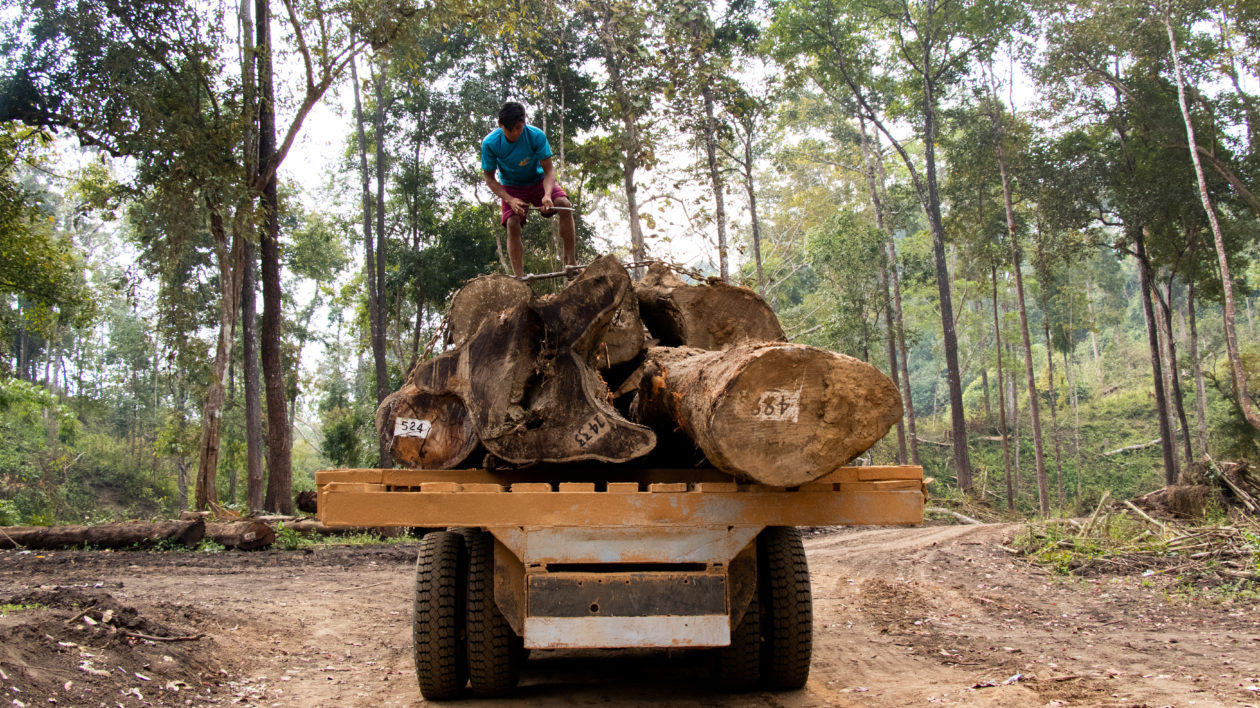
Muddy and bruised from the day’s work, it’s late afternoon by the time we trek back to camp. For the last kilometer we follow another narrow streambed, squeezing past a mature bull elephant silently munching bamboo in the sun. When we arrive, two huge flatbed trucks loaded with teak logs are parked in the center of the clearing. A Kawasaki log-loader grasps an 8-meter-long trunk and stacks it delicately atop the pile, the truck groaning with the added weight.
Each of these logs is likely worth between $10,000 and 20,000 USD, and their value will only increase as the teak reserves are further depleted. This wealth grows within one of the poorest countries in the world, with a national poverty rate of at least 26 percent.
It’s a paradox that highlights the Burmese government’s challenge: Forests are one of their most valuable resources, essential to helping pull the country out of poverty. And yet without proper management they will disappear for centuries, leaving millions of Burmese bereft.
“Economic development is essential, but at the same time, need to create policies and practices to avoid damage to our natural resources as we develop,” says Tint Lwin Thaung. “Conservation and economic development really can go together.”
Otherwise, all that will remain are the footprints of long-dead elephants preserved in the monsoon muds, marking a forgotten track through a forest of stumps.




Very informative
free the elephants
making them work for money…disgusting
and
BOYCOTT BURMA UNTIL IT IS TRULY FREE !!!
Burmas is still at WAR
if you go there YOU CONDONE WAR AND MASS TRIBAL MURDER ( by the budist dictatorship under aung san poo traitor)
AND HELP TO PAY FOR IT!
BRILLIANT WORK, JUSTINE! KEEP IT UP AND TREAT US TO LOTS OF BURMA STORIES! I HAPPEN TO HAVE A DEEP CONNEXION WITH BURMA, AND I WAS THRILLED TO DISCOVER YOUR AMAZING STORY! THANK YOU! JOHNNY ROSEN. LAKE WALES, FLORIDA.